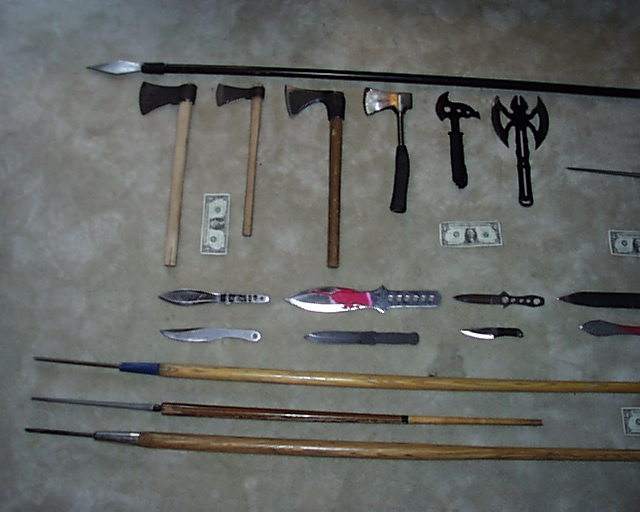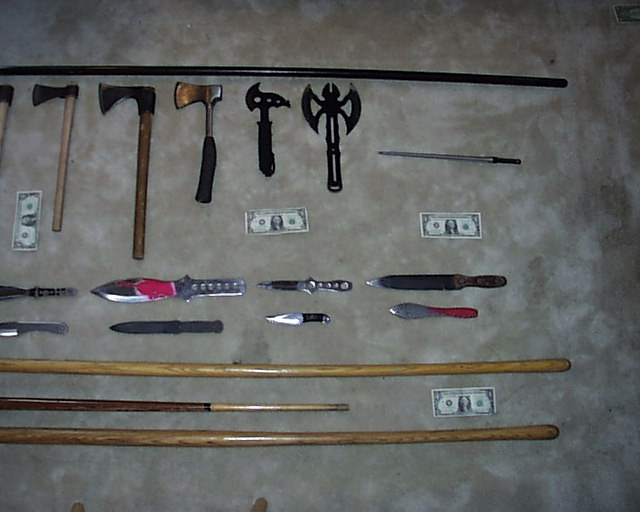Types of Weapons
While there is a dizzying array of weapons available that can be thrown, shown here are more common examples. Keep in mind that every manufacturer has unique dimensions that they use. In the case of forged tomahawks, each is made by hand, one at a time. A single source for hawks in the East Kingdom carries half a dozen different french hawks, listing the different weights in ounces.
In the East, we try like to keep an open mind and try to restrict weapons only for damage and safety (see the current rules section.)
Photos below show common weapons available with dollar bills included for scale.

With the axes going left to right, starting at the top:
Standard tomahawk:
Likely the first weapon given by a marshal to an adult thrower, since it is often considered the easiest weapon to throw and make stick. Most marshals have these axes available. Standard tomahawks are readily available and reasonable beginning price range begins at about 20 dollars. Approximate size: 18” length, 3 ½” blade length, 2lbs.
Small forged tomahawk/mousehawk:
It’s similar to the standard tomahawk but ⅔ to ¾ the size and weight. This is a good weapon for children or smaller adults. Some smaller adults have a better experience with the mouse hawk to learn proper throwing technique. Student may transition from the mousehawk to standard tomahawk within half an hour. 14″ overall length, 2″ blade length, 1 lbs.
French hawk:
This is a very old style that is excellent for throwing. The raised tip of the head allows the french hawk to stick over a greater range of rotation. French hawks have the broadest range of weight and size of any ax design, but in weight they’re generally between the standard and mouse hawks. 18″-20″ overall length, 3 1/2″ blade length.
Camping ax:
Although not period, they’re readily available in any hardware store and can be bought for as little as 5 dollars. The handles are made from wood or steel (head is permanently attached with steel handled axes.)
Handles:
A wooden tomahawk handle averages 5 dollars, and as a courtesy it’s asked that a thrower replaces handles that they break when borrowing axes.
Throwing knives:
There is a wide variety of knives available. Knives are harder to throw than axes, since they are made to only stick on their blade tip. Larger knives are generally easier (they throw like axes.) Knives eight inches from end to end are a minimum length that should be considered, but the heavier the better. Everyone when starting out wants to use tiny knives (must be a carry over from dart throwing.) Many knives made for throwing are made of one piece of steel with no additional handle material (wood or leather.)
Damaged handles and safety concerns:
Damaged handles can be hazardous to throwers. Marshals need to pay special attention to the safety of handles. Folding knives and knives that are irreplaceable should not be thrown on the range due to likelihood of damage.
Spear:
In SCA thrown weapons spears aren’t as popular as axes and knives. Cost, space, and rotation can deter throwers. However, spears can be made cheaply from hardware store materials and they don’t have to be eight feet long. The spear at the top of the photos is a flat steel head on a wood mop handle. The handles of all the spears on the bottom of the page were made from rake handles or pool cues. The heads were made from large nails/spikes or an SKS bayonet (like the one pictured below on the far right next to the axes.)

Pictured below are some stranger weapons to be found on the range. Starting from the top going left to right:

Shakra: Thrown like a Frisbee (this means it’s a sidearm throw and needs to be cleared with the marshal.)
Pizza cutter: Throws like a knife.
Special Forces Shovel: The manufacturer claims this can be thrown like an ax as the edges can be sharpened. Despite the name, when asked, Special Forces have said this would not be their weapon of choice in an emergency.
Bolo machete/knife: Military styled heavy knife. This weapon doesn’t have a point, but will stick when thrown correctly.
Chinese sword: Few knives are heavier than the Chinese sword.
Viking/Norse ax: Essentially a different style of tomahawk.
Machete: Long rotation, lightweight. The blade is tempered like a spring, so if it doesn’t stick it could bounce much further than some weapons. This knife may be more challenging on windy days.
Two-handed ax: Available in many sizes and styles. The rotation is much larger, once in 22 feet. Lighter targets can be destroyed by two-handed axes. While thrilling and attention-getting, they are often considered advanced throwing axes.

